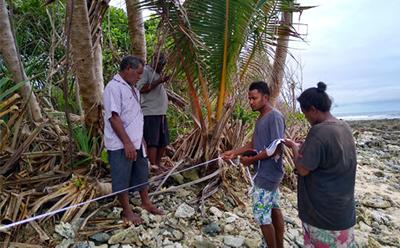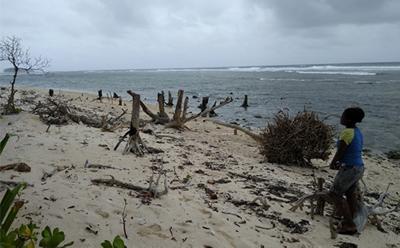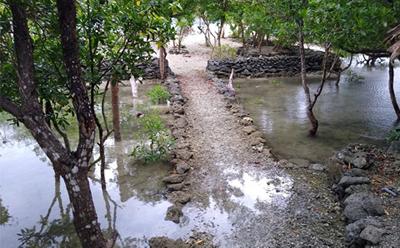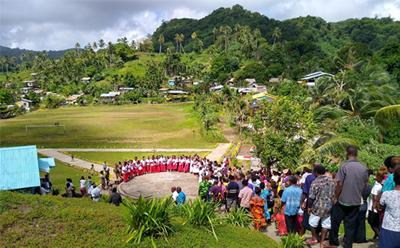Climate change in a Melanesian context

Marie Schlenker is a PhD student within the Energy and Climate Change Research Group at the University of Southampton, researching the impact of climate change and coastal hazards on the Solomon Islands. Her interdisciplinary project is jointly supervised by Prof Robert Nicholls, Prof David Sear and Dr Ivan Haigh and supported by the Melanesian Mission UK, the Anglican Church of Melanesia and the Southampton Marine & Maritime Institute. She has just returned from a 2-months long fieldtrip to the Solomon Islands.
*******
When I first started my PhD project about climate change impacts in the Solomon Islands, neither myself nor my supervisors expected that I would be telling a story about land disputes, traditional customs and the wantok system. I considered myself a natural scientist, with an academic background in Geosciences and Environmental Physics, keen to collect and analyse numerical data. However, as I started delving into my project, I had to rethink this initial perception. How can I study climate change impacts if I do not consider the people who are being impacted by it?

My research still focuses on the analysis of physical data to gain insights into climate change impacts in the Solomon Islands. I use satellite images, aerial photographs and beach surveys to understand how shorelines of small islands have changed in the past and how they might evolve in a changing climate. However, I also added a significant social science component to my work. During my two-months long fieldtrip to the Solomon Islands, I conducted interviews and participatory workshops with local people to learn more about their perceptions of climate change and its impacts on coastal areas in the country.
Both, government representatives and leaders of the Anglican Church, confirmed what I had already expected: many coastal communities in the Solomon Islands are already experiencing adverse impacts of environmental change, including severe shoreline erosion and increased flooding frequency. The good news is that the majority of these communities seem to be highly resilient to the new environmental conditions. Most Solomon Islanders live a simple lifestyle in rural areas. They reside in palm leaf or wooden huts and subsist on fishing and growing crops in small gardens. As shoreline erosion and flooding threaten their villages, people simply dismantle their houses and rebuild them further inland on higher ground. Due to the strong sense of solidarity and social cohesion within extended families, known as the wantok system, people who are forced to relocate will receive boundless support from their relatives.

While this system of assisted relocation within villages currently seems to work well in many places across the Solomon Islands, it is simply not an option in some other places. Why? Some communities do not own any land to fall back onto. As part of my trip, I visited two communities in South Malaita, Fanalei and Walande, which have been dealing with this problem. Both communities are seafarers from Lau Lagoon in North Malaita who migrated to the small islands off the South Malaitan coast generations ago and have been growing ever since. Their status as migrants means that they do not have any original ancestral lands in the region. Land ownership in the Solomon Islands is tribal and passed down from generation to generation. As rural communities depend on the land for their survival, they guard it like nothing else.
Fanalei and Walande have experienced severe shoreline erosion and flooding in recent years. Fanalei community lost the majority of its former settlement area to the waves and is regularly flooded at high tide. Walande transformed from an island that hosted a population of over 1,000 people in 2002 to a deserted sandbank. As a result, the majority of the villagers migrated to the nearby mainland of South Malaita. Unfortunately, not without complications. Fanalei people are illegal settlers on the mainland and the traditional landowners will not let the issue slide, leaving Fanalei Islanders with an uncertain, possibly bleak future. Land ownership and land use are common sources of conflict in the Solomon Islands and even led to violent ethnic tensions in the past. Unfortunately, climate change and population growth are very likely to significantly exacerbate the issue over the next decades and, currently, the Solomon Islands government neither has the capacity to handle the increasing number of land disputes, nor to effectively support resettlement or to slow down the alarmingly high rate of population growth.

However, just a few kilometres further north, Walande people have found their own strategy to secure their livelihoods. In the 1940s and 50s, Walande’s leaders had the wise foresight to acquire land from tribes on the mainland by negotiating a payment consisting of traditional shell money, dolphin teeth and modern currency and maintaining close friendships with their neighbours. After Cyclone Namu hit the island in 1986, the villagers decided to take their fate in their own hands. Educated community members created a settlement plan and obtained the support of Australian Aid to bulldoze the land for relocation. When storms were becoming more frequent in the 2000s, leading to increased erosion and flooding of Walande Island, villagers had the opportunity to build a safe new home on the mainland.
The story of Walande shows that rural communities in the Solomon Islands are capable to manage their own local climate change adaptation. However, any kind of support from outside is greatly appreciated by the communities and can go a long way. The Melanesian Mission UK currently supports the development of an environment observatory within the Anglican Church of Melanesia, which will empower local people to create their own scientific evidence of climate change and shoreline erosion, increase environmental knowledge within communities and facilitate the design of effective adaptation strategies.
More information about the communities of Fanalei and Walande and the ACoM Environment Observatory can be found in my travel blog.

